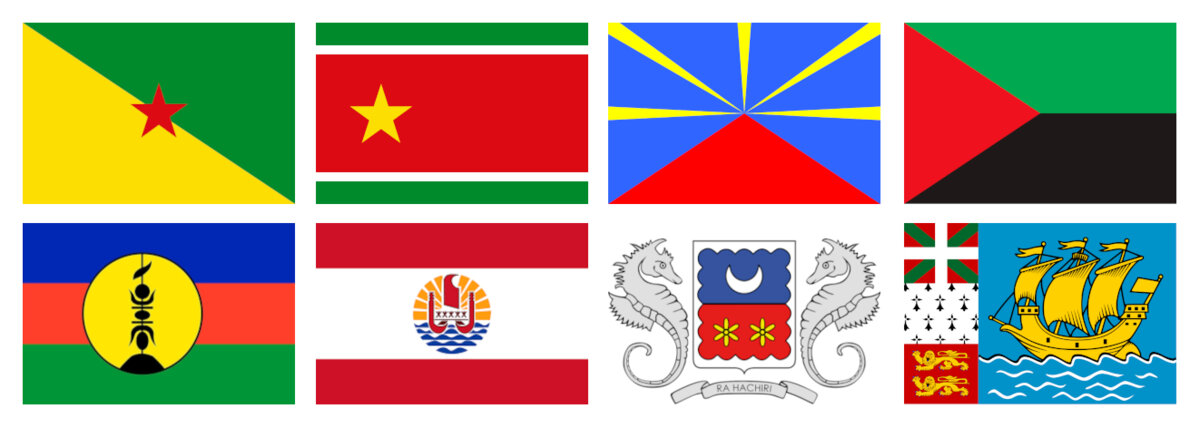
Agrandissement : Illustration 1

As a former colonial empire, France has an array of inhabited territories that lie outside the continent of Europe and have remained part of the state after the decolonisation process that followed the second world war. These are referred to in French as La France d’outre-mer (“Overseas France”).
The French Empire had a more centralising and integrationist approach to colonisation than the ad hoc patchwork of the British Empire. A significant number of its territories that did not make a ‘clean break’ after the war have since become French administrative départements and regions, with exactly the same status as the mainland regions. These are: French Guiana (South America), Guadeloupe (Caribbean), Martinique (Caribbean), Mayotte (Indian Ocean), and Réunion (Indian Ocean). There are also a number of ‘overseas collectivities’, with hybrid constitutions that allow them a certain number of devolved powers. These include: French Polynesia, Saint Barthélemy (Caribbean) and Saint Pierre and Miquelon (North America). And the possibility exists for these collectivities to obtain full integration as French regions, via a referendum. The decision to do precisely this was taken in Mayotte in 2009, and enacted in 2011. Finally, New Caledonia, near Australia in the Pacific Ocean, has a sui generis status and a specific chapter dedicated to its governance in the French constitution.
Each of these overseas territories has its own issues, strengths and mixtures of cultural identities. However, there are also a variety of core challenges that tend to be shared among them. These include: the difficulties involved in balancing the rights of indigenous peoples with those of various other postcolonial communities, political tension between independence movements and pro-integration groups, meterological disasters and threats related to climate change, immigration and nationality issues, practical administrative difficulties due to the distance from mainland France and the time-difference, tensions between military and non-military communities, specific medical challenges, and a variety of social issues related to higher levels of economic inequality than are generally found in mainland France.
Recent events that have been reported in the English language press include the devastating cyclone that ravaged Mayotte in December and the rioting in New Caledonia after the government proposed extending voting rights to recent settlers. However, it is often only at points of crisis like these that reporting gains much penetration outside the French media, and even their aftermath tends to receive sparse coverage. We believe that the French overseas territories deserve slightly more in-depth reporting in English, including the kinds of stories that are written by local journalists.
This blog, the thirteenth journalism translation project by students of the MéLexTra JET master’s degree in English-French translation at the University of Lille, is aimed at readers of Mediapart English who wish to learn a little more about French media coverage of these issues. It seeks to tease out some of the cultural tensions and acommodations between conflicting concepts in the French media’s reporting about and from its overseas territories.
Who are we?
Fifteen students completing their second year ‘JET’ master’s degrees (Traduction Juridique et Technique) specialising in legal and technical translation between French and English. This project is part of a module (Traduction journalistique) in which French journalism is translated into English. It is overseen and edited by the module’s teacher, applying a collaborative student-centred learning approach in the ‘newsroom class’.
Translators:
Aurélien AUBIN
Morgane BERTHET-BONDET
Leïla BOSSEMAN
Kathel BOURHIS
Maxime CARPENTIER
Emeline GUILLOT
Inès KRAMM
Johana LECLAIR
Mathieu MINOT
Maxime MOREAU
Tabatha PICARD
Clémentine RAUD
Edgar RENAUD
Nissrine VANSTAEN
Editor: Sam TRAINOR
What sorts of articles are translated?
The project has two main goals. The first is to allow non-French readers to get a slightly better idea of what life is like in France’s overseas territories, and to delve a little deeper into the key debates surrounding their status and governance. The second is to provide readers with an idea of how local and global issues related to the broader topic are reported and discussed in the French press, and what this might reveal about the country’s news media.
Articles are taken from a wide variety of local, national and international French journalistic sources, appearing in print, broadcast and online. The project seeks, in part, to give non-French readers an insight into the various ideological leanings of the different sections of the French media and how these correlate (or not) with their positions regarding these issues. Articles will therefore be selected from sources with a broad spectrum of political leanings. An introductory (‘standfirst’) paragraph always provides some brief information on the source context.
Where can the original articles be found?
In every case, copyright and publishing details are provided in the translations: the original authors, photographers etc. are always indicated. Links are also provided to online versions of the original articles in their original publishing context, wherever possible.
What is our translation policy?
Translations are initially provided by groups of three students, one of which is the initial or lead translator. Following a 'strategic layering' approach, a second translator is responsible for sourcing and translating any quotations or other 'source level material' in the article, and the lead translator then adapts this material to his/her translation of the journalist's copy. Finally, the third student acts as an editorial spokesperson for the article in the news room meeting. The articles are sub-edited by the project editor, who also provides 'editorial level material' (like the headline, standfirst, notes etc.), and the article is then posted online. The article then potentially undergoes a final modification by the editors of Mediapart English before being moved to the club section of the paper’s front page. One of the key goals of the project is to give non-French readers an idea of how the issues are presented in the French media. Some aspects of French journalistic style are therefore preserved in the translations. For a related reason, a number of terms are left in French, with links to a glossary article being preferred to explanatory translations. These include, for example, terms for local geographical areas, like département, and titles of political offices, such as député and préfet.
What kind of English is used in MéLexTra blogs?
Mediapart being a European publication, British English spellings are used throughout, as are predominantly British English grammar and vocabulary. However, the French constitution and political context being closer in some circumstances to the language culture of the United States than the United Kingdom, there are a handful of globally recognisable American English idioms that have naturally been incorporated in previous projects. Presidential candidates, for example, are said to be ‘running for office’ rather than ‘standing for election’.
House style meets the "Translation Bible"
The French term "Bible de traduction" is a concept borrowed from professional audiovisual translation practice, where the subtitlers or dubbing authors of a television series establish and share a set of fixed translation solutions and equivalences for recurring terms which, for reasons of continuity, all collaborators are asked to follow. One of the main features of this annual translation project is the continual expansion and renewal of what might be considered an expanded house 'style guide', specifically adapted to the translation of politically inflected French news journalism in English. In the 'editorial classroom', students not only pitch, discuss and choose between articles for translation, mirroring the activity of a traditional newsroom, but they also discuss specific translation choices and the possibility of adding a new, potentially recurring translation solution as a conventional equivalence in the project's style guide.



